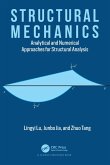Ario and Zawidzki show readers how to handle symmetric structures in engineering using group-theoretic bifurcation theory as a mathematical tool for the finite element analysis of symmetric structures.
They guide the reader from the initial mathematical concepts through to application examples. Readers will gain a solid theoretical grounding in group theory and strong working knowledge of the use of computational frameworks for structural analysis using mathematical representations of symmetry and physical symmetry. First, the authors elaborate an outline of symmetric structures in engineering and then describe the representation of symmetry and group theory. They then discuss block diagonalization theory and finite element analysis models. This provides readers with the base knowledge needed for Chapter 6, which is based on numerical analysis examples of invariant, static FEM model systems and dynamic model systems of the dihedral group. This unique approach is a vital method that will enable readers to reduce the time and computation needed for accurate analysis so that they can better design such structures. The focus on finite element methods and practical examples and case studies throughout provides a strong practical foundation for anyone studying or working in this field.
The book is a valuable resource for undergraduate and postgraduate students on various courses such as civil and mechanical engineering, architecture, structural engineering, applied mathematics, and physics. Additionally, it describes vital practical solutions for structural engineers, structural system manufacturers, fabricators of prefabricated elements, and developers of computational mechanics and so on.
They guide the reader from the initial mathematical concepts through to application examples. Readers will gain a solid theoretical grounding in group theory and strong working knowledge of the use of computational frameworks for structural analysis using mathematical representations of symmetry and physical symmetry. First, the authors elaborate an outline of symmetric structures in engineering and then describe the representation of symmetry and group theory. They then discuss block diagonalization theory and finite element analysis models. This provides readers with the base knowledge needed for Chapter 6, which is based on numerical analysis examples of invariant, static FEM model systems and dynamic model systems of the dihedral group. This unique approach is a vital method that will enable readers to reduce the time and computation needed for accurate analysis so that they can better design such structures. The focus on finite element methods and practical examples and case studies throughout provides a strong practical foundation for anyone studying or working in this field.
The book is a valuable resource for undergraduate and postgraduate students on various courses such as civil and mechanical engineering, architecture, structural engineering, applied mathematics, and physics. Additionally, it describes vital practical solutions for structural engineers, structural system manufacturers, fabricators of prefabricated elements, and developers of computational mechanics and so on.
"In the realm of science and engineering symmetry often plays a central role, determining the form and behavior of structures. This book presents rigorous mathematical description of several types and examples of structural symmetry.
Chapter 1 is an introduction to the symmetry in Japanese art - from precise creases of origami to the elaborate patterns of bamboo weaving and the intriguing balance of toys such as the Yajirobee.
Here the reader is given a tangible connection between everyday experience and the abstract world of symmetry.
Chapter 2 introduces rigorous foundations of the group theory, showcasing how the seemingly simple concept of symmetry can be mathematically described, classified, and represented. Here the reader is provided with mathematical tools necessary for full understanding of the subsequent chapters.
Chapter 3 merges abstract concepts with practical examples, presenting group theory in the context of structural mechanics.
Chapter 4 provides an in-depth look at the Finite Element Method, a powerful tool for engineers and scientists.
The following parts of the book illustrate the applications of group theory to real-world symmetric structures, illustrated with several examples from purely academic to industrial applications.
This book is intended for a wide range of readers: for students of science and engineering who will find meaningful connections between fundamental concepts and practical applications; for engineers and chemists, whether in academia or in industry, who will find it as a valuable source of insights for shape research and in-form design. Last but not least, the book serves as an inspiration and guide for anyone who is curious about the myriad of ways in which symmetry is present in our world. Embrace the mathematical rhythms that underpin the symmetrical wonders around us!"
- Professor Miroslaw J. Skibniewski, University of Maryland, College Park, United States of America
"This book, which focuses on 'Symmetry' - the singular intersection of mathematics and physics, promises to open doors to new academic worlds for its readers. Not only does it delve deeply into specialized concepts such as group theory and finite element methods, but it also reveals the mathematical elements hidden in ordinary items like traditional bamboo crafts and children's toys. By picking up this book, you will notice the mathematical charm behind the things around you. From young students to professionals, this book offers fresh knowledge and perspectives to all its readers. It's bound to enrich your interdisciplinary exploration journey. I recommend you to take this book in your hands and take the first step into the unknown world."
- Professor Masatoshi Nakazawa, Tohoku-gakuin University
Chapter 1 is an introduction to the symmetry in Japanese art - from precise creases of origami to the elaborate patterns of bamboo weaving and the intriguing balance of toys such as the Yajirobee.
Here the reader is given a tangible connection between everyday experience and the abstract world of symmetry.
Chapter 2 introduces rigorous foundations of the group theory, showcasing how the seemingly simple concept of symmetry can be mathematically described, classified, and represented. Here the reader is provided with mathematical tools necessary for full understanding of the subsequent chapters.
Chapter 3 merges abstract concepts with practical examples, presenting group theory in the context of structural mechanics.
Chapter 4 provides an in-depth look at the Finite Element Method, a powerful tool for engineers and scientists.
The following parts of the book illustrate the applications of group theory to real-world symmetric structures, illustrated with several examples from purely academic to industrial applications.
This book is intended for a wide range of readers: for students of science and engineering who will find meaningful connections between fundamental concepts and practical applications; for engineers and chemists, whether in academia or in industry, who will find it as a valuable source of insights for shape research and in-form design. Last but not least, the book serves as an inspiration and guide for anyone who is curious about the myriad of ways in which symmetry is present in our world. Embrace the mathematical rhythms that underpin the symmetrical wonders around us!"
- Professor Miroslaw J. Skibniewski, University of Maryland, College Park, United States of America
"This book, which focuses on 'Symmetry' - the singular intersection of mathematics and physics, promises to open doors to new academic worlds for its readers. Not only does it delve deeply into specialized concepts such as group theory and finite element methods, but it also reveals the mathematical elements hidden in ordinary items like traditional bamboo crafts and children's toys. By picking up this book, you will notice the mathematical charm behind the things around you. From young students to professionals, this book offers fresh knowledge and perspectives to all its readers. It's bound to enrich your interdisciplinary exploration journey. I recommend you to take this book in your hands and take the first step into the unknown world."
- Professor Masatoshi Nakazawa, Tohoku-gakuin University








